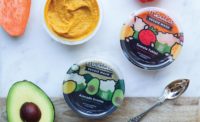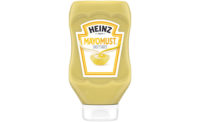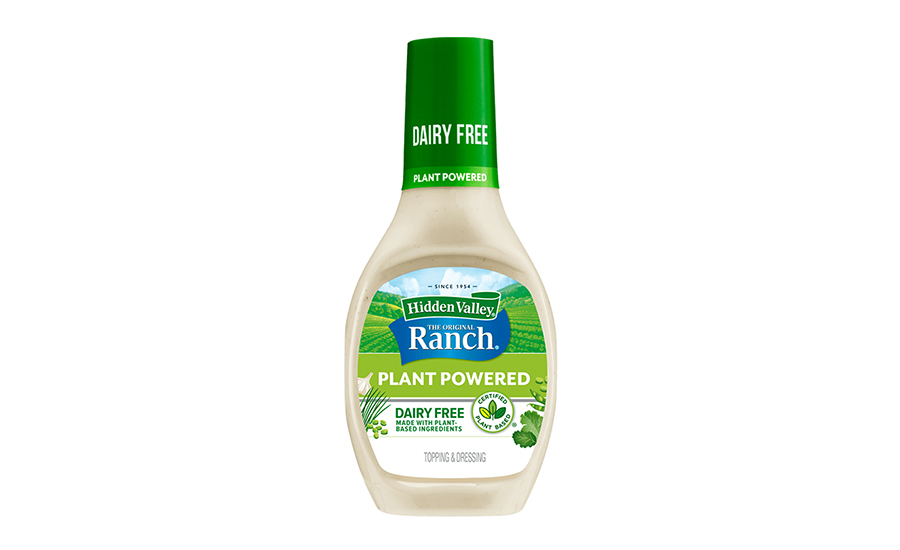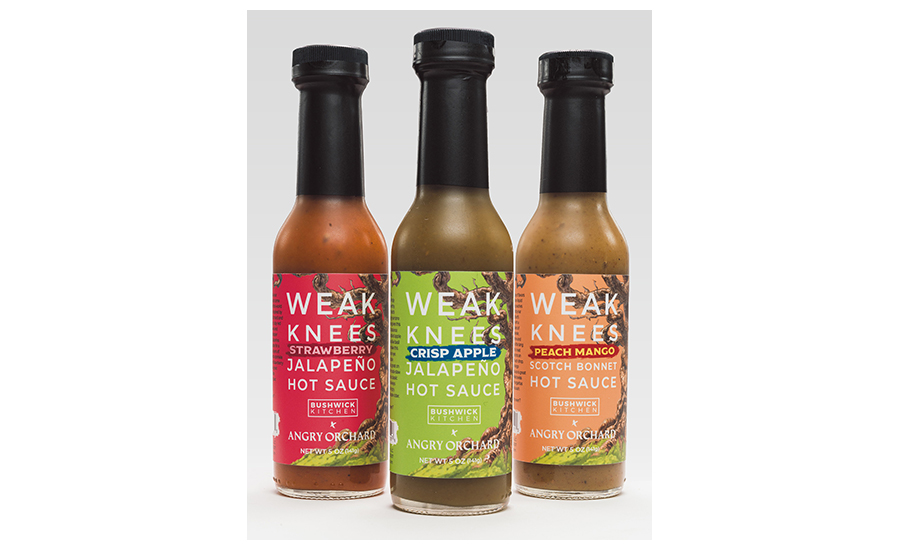STATE OF THE INDUSTRY: 2022
Sauces, Dressings and Spreads Angle to Fulfill Tastes, Trends
Plant based ingredients and adventurous consumers continue to inspire product developers

PHOTO CREDIT: Getty Images / Ridofranz

Plant the Flag! Plant-based offerings expand throughout dressings, sauces and spreads.
PHOTO COURTESY OF: The Clorox Company

Kneed Some Heat? Bushwick Kitchen partnered with Angry Orchard for new hot sauces.
PHOTO COURTESY OF: Bushwick Kitchen

Spread the News! More plant-based offerings in the spread, dip category.
PHOTO COURTESY OF: The Happy Vegan LLC

Have Tastebuds, Will Travel! Lucky Foods introduced Seoul Kimchi Ketchup and Seoul Kimchi Mayo.
PHOTO COURTESY OF: Lucky Foods

Want Fun Flavor? Raise the Bar! Not ready for a night out? New Dean’s Dips Sports Bar line brings popular flavors home.
PHOTO COURTESY OF: Ventura Foods






Just as there are so many ingredients combined in a good sauce, there are many factors that combine to impact new product development in sauces, dressings and spreads. And this is true—seemingly for better and for worse.
It’s no secret that interest in sauces, dressings and spreads relates to consumers’ travel and experience of different cultures. Unfortunately, the nation’s COVID pandemic—particularly in 2020—has hampered that travel. Moreover, Innova Market Insights’ 2021 Lifestyles and Attitudes Survey found that 26% of Americans say that they expect to travel less even after the pandemic ends.
Then again, a drop in foodservice traffic and more at-home eating (particularly in 2020) boded well for prepared sauces, dressings and spreads.
While the pandemic has roiled travel plans, it has not extinguished the desire for novelty. Another Innova 2021 survey found that 51% of Americans say that they like to try new foods that they have never tasted before. Long-term, this is good news for sauce and spread makers, though innovation continues to be challenged in the short-term.
US launches of sauces and seasonings declined 4.1% from January to November 2021 versus the same year ago period, per the Innova Database of new products. Spread launches also fell 3.2% during this time.
Part of this decline may be due to the reliance on small companies to drive innovation. Innova data show that small and medium size companies (outside of the top 100 FMCG firms by sales) accounted for approximately 93% of all sauce and seasoning innovation in 2021. And for whatever reasons—no doubt including related supply chain factors—those smaller companies were not as active last year.
Innova Market Insights tracking data show that introductions of new table sauces slowed in 2021 and were down more than 15% from January to November 2021, compared to the previous year. Launches of mayonnaise and dressings also were down by about 21%. One bright spot, however, involves cooking sauces with saw a 15% increase in year-over-year new product introductions.
Results were muted in the spreads category. Dips—those items often consumed in social gatherings—saw new product introductions plunge nearly 12% during Innova’s January to November 2021 tracking period. Similar introductions of nut spreads dipped by about 3% while fruit spreads actually expanded by more than 3%.
Looking at sauces and seasonings—a category including salad dressings—the plant-based trend has been hot of late. As recently as 2018, fewer than 1% of category launches made a plant-based claim. That figure rose to just more than 5% in 2021.
Plant the Flag!
The plant-based trend has been challenging for sauce and dressing products made with dairy ingredients. One popular category, ranch dressing, is seeing changes with products like Only Plant Based Ranch Dressing (Only Plant Based, Newtownards, Northern Ireland); and Marie’s Plant Based Creamy Dill Ranch Dressing (Ventura Foods LLC, Brea, Calif.).
Even the ranch dressing standard bearer, Hidden Valley Ranch, is changing. Last year saw The Clorox Company introduce Hidden Valley Ranch Plant Powered Dairy Free Dressing.
The plant-based trend is also impacting categories like mayonnaise and gravy. One dairy-free example includes Primal Nutrition’s Primal Kitchen Mushroom Gravy made with cashew butter.
Full Flavor
Sauces and seasonings tend to be rich with flavor innovation, and one trend here is the rise of flavors such as kimchi. Innova Market Insights tracking data show that this popular Korean product—as a flavor—doubled in the number of new launches of sauces and seasonings between 2019 and 2021.
Examples include Seoul Kimchi Ketchup and a Seoul Kimchi Mayo from Lucky Foods, Tulatin, Ore.
Barbecue sauce is moving in new directions. J&J Group LLC, Overland Park, Kan., partnered with Boulevard Brewing Co. to develop and launch three co-branded Rufus Teague Boulevard Brewing Co. “Can-O-Que” BBQ Sauces that feature actual beer and come packaged in a beer can. In other news, the McIlhenny Company showed its sweeter side with Tabasco Honey BBQ Sauce.
Street foods also influence sauce innovation. B&G Foods Inc., Parsippany, N.J., developed three Ortega Street Taco Sauces and three Ortega Street Taco Crockpot Seasoning Mixes.
Big brand innovation included Kraft Heinz, which introduced new mash-ups such as Heinz Sweet Ketchili Sauce (ketchup and chili sauce) and Buffaranch (Buffalo and ranch sauces). Sir Kensington’s, New York, N.Y. (Unilever), partnered with another big name, model Chrissy Teigen, to introduce Chrissy Teigen’s Honey Mustard Fry Sauce.
In other news, Bushwick Kitchen, Washington, D.C., partnered with Boston Beer Company’s Angry Orchard Cider Brand. The result was a three-item line of Weak Knees sauces including Crisp Apple Jalapeno, Strawberry Jalapeno and a Peach Mango Scotch Bonnet.
Sauce packaging can be a challenge for single-person households. That’s why Mizkan America Inc., Mount Prospect, Ill., developed Ragu For One Meat Sauce in single-serve pouches. The need is clear: single-person households now represent 28% of all households in the USA, per the U.S. Census Bureau.
Spread the News
Turning to dips and spreads, the plant-based trend is flourishing here. In 2021, more than 8% of new US spreads made a plant-based claim—and that’s up from just 1% of similar launches in 2018.
That means we’ll be seeing more launches like a Dairy Free Tzatziki from Kite Hill, Hayard, Calif.; or a Notcho Nocheez Cheez Dip Almond Spread from The Happy Vegan LLC, Pittsburgh, Pa.
One plant-based ingredient gaining traction in spreads is oats. Jakera and Co., Los Angeles, offers a Vanilla Almond Oat Butter. Meanwhile, New Zealand’s Fix and Fogg—with a US outlet in Houston—offers Oaty Nut Butter.
The clean label trend is a headliner in spreads. McCormick & Company, Hunt Valley, Md., made that clear with its McCormick Just 5 Simple Ingredients Homestyle Ranch Dip, Dressing and Seasoning Mix. JM Smucker Co., Orrville, Ohio, takes a similar approach with Smucker’s Simply Fruit spreads, which are “sweetened with ingredients made from real fruit.”
Ventura Foods came up with noteworthy flavor innovation in its Dean’s Dairy Dip Sports Bar line. Last summer brought four intriguing flavors including Classic Pepperoni Pizza, Spicy Nashville Hot, Crispy Deep Fried Pickle and Tangy Buffalo Wing.
Salsa products turned up the heat with more hot and spicy innovation. Among new offerings from Stonewall Kitchen, York, Maine, was a Carolina Reaper Salsa. South Korea’s Daesang Corporation also introduced O Food Gochujang Salsa, a fusion of sauce and salsa.
Hummus also went spicy—from coast to coast. Last year saw Southern California retailer Bristol Farms introduce its own Organic Hummus Hatch Green Chile. Ithaca Hummus, Rochester, N.Y., also introduced Buffalo Ranch Hummus.
Many spread products—such as peanut butter and jelly—are aimed at kids. Given their unique nutritional needs, don’t be surprised to see more functional launches such as Brainiac Butter from San Francisco’s Ingenuity Brands. There are two varieties—Chocolate Peanut and Honey Peanut—and each is fortified with omega-3 fatty acids, choline and protein.
Tom Vierhile is vice president of Strategic Insights, North America for the Netherlands-based Innova Market Insights and has more than 20 years of experience in new consumer packaged goods reporting and analysis. Tom holds a bachelor’s degree in marketing from St. Bonaventure University and an MBA from the State University of New York at Buffalo. Follow him on Twitter at @TomVierhile.
Looking for a reprint of this article?
From high-res PDFs to custom plaques, order your copy today!












